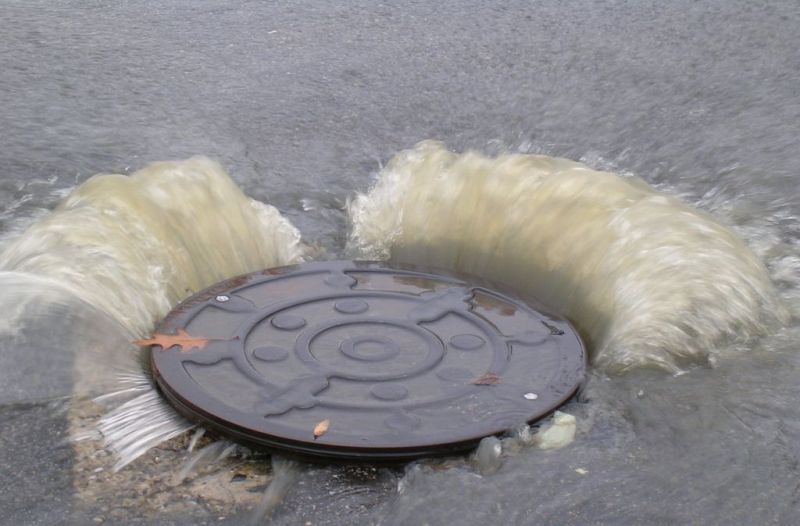One of the most repulsive things about post-storm cleanup involves wading through fetid water filled with raw sewage.
That plight is not exclusive to post-hurricane recovery — fecal pathogens in leaks and spills now often pollute stormwater after heavy rains.
Climate change is coming for our backyard septic tanks, and eventually, our municipal waste treatment systems.
“In the long run, sea level rise is going to overrun all of this,” Lawrence Cahoon, a biology professor and researcher at the University of North Carolina Wilmington, said in a recent interview. “I think if we’re going to live on the coast for any length of time, sewer systems are going to let us down and septic systems are going to fail. They already are.”
Septic systems are widely used in coastal North Carolina to dispense with human waste, our humble byproduct and vector of disease. But higher groundwater, more rain deluges and epic flooding from intense storms have been causing systems to leak or become inoperable.
Those same climate forces also risk compromising the aged and deteriorating municipal sewer systems that service mostly urban communities.
“The solution is to fix the system,” Cahoon said. “Generally, the problem is people don’t want to spend the money to do it.”
Costs for public wastewater treatment plant systems are usually borne by the local government, which cover the expense through bonds and hookup fees to the property owner. Some governments, such as Brunswick County’s, have water and sewer systems operated through a separate authority.
In rural Tyrrell County, a northeast county with a high poverty rate, septic systems in the wetlands-dominated communities had been failing for years. Thanks to a grant from the state Clean Water Management Trust Fund, about 65% of the county’s communities have been hooked up to a complex sewer system that has a pump and tank at each property, said county manager David Clegg.
The county completed that first phase of construction in the early 2000s. A second phase was completed in 2011 and a third in 2018. The next phase is in the planning stages and county officials are seeking funding.
Since gravity systems aren’t an option, the waste has to be pumped miles away to a treatment plant. So far, the system has cost about $20 million and needs about $10 million more to be completed, Clegg said.
Tyrrell, ranked one of the most economically distressed counties in the state, could never afford such a costly system without help. But wastewater treatment plants are a fiscal challenge even for wealthier communities.
“Central sewer is hideously expensive,” Cahoon said, “and if something goes wrong, you can’t afford to fix it.”
Older infrastructure typically includes cast-iron pipes, which tend to corrode, he said. As long as the joints are sound, sewer pipes made from PVC are durable and reliable.
Upgrades to corroding systems, however, can be cost-prohibitive, and full replacement would be more so.
“There’s not enough money in the world to do this,” Cahoon said.
Along with Marc Hanke at University of Houston Honors College, Cahoon researched the effects of inflow and infiltration, or I&I, on sewer plants. Inflow is water coming from above ground, such as a manhole. Infiltration is groundwater seeping through breaches, such as cracks in pipes.
One impetus for the research, he said, was the lack of understanding about the impacts of higher mean sea level on the systems: how much saltwater intrusion was evident? What is happening with tidal influences? What effects are heavy rain and higher groundwater levels having on flow and capacity?
According to the study published in 2017 in Water Science & Technology, I&I can cause system overflows and degradation of systems and impair water quality. The research analyzed system flow responses to rainfall and temperature at 93 gravity-collection wastewater treatment plants in eastern North Carolina.
Data on hurricanes was purposely not included.
“I wanted to know what’s going on, on a regular basis,” Cahoon said.
Over two years, the research looked at coastal water gauges and daily tides, as well as data on rates of sea level rise, temperatures, and cumulative and daily rainfall amounts.
Since there’s a limit in how much to design for, even the newest plants are not immune to spills during big storms that overwhelm the system. For instance, a 2-inch rainstorm can produce about 40% extra flow.
“So if that 40% carries you over the capacity of the plant,” Cahoon said, “you probably will have spills, or poor treatment, or both.”
State regulators recognize that the systems’ design can’t accommodate huge volumes of rain and allow up to 1,000 gallons to be spilled before a reporting requirement kicks in.
Often, Cahoon said, the property owners’ pipes that hook up to the public system need repair or replacement.
“The average owner has no clue” about their condition, Cahoon said, adding: “The connector pipes are probably half the system.”
The study found that heavy rainfall, temperature — likely as effects of seasonal variation in groundwater levels — and sea level, expressed as a day’s highest tide, all had significant effects on 90% of the wastewater treatment systems in coastal North Carolina.
“These collective results demonstrate the potential vulnerability of coastal wastewater collection and treatment systems to breaches in system integrity that allow extraneous flows, primarily through groundwater elevation, to drive further infrastructure degradation and environmental pollution,” Cahoon and Hanke wrote.
Last year, another team of researchers began a study, Wastewater Infrastructure Tipping Points: Prioritizing Implementation of Climate Adaptation Plans in Decentralized Systems, focused on septic systems, including single residential tanks as well as “package” systems, onsite treatment plants that serve larger facilities or a group of properties in a neighborhood. Extreme rainfall and high-tide flooding, as well as rising sea levels, have threatened the function and effectiveness of septic systems, especially on the coast, according to the abstract.
The two-year study was funded by a grant of about $300,000 from the National Oceanic and Atmospheric Administration’s Climate Program Office.
Working in partnership with the towns of Nags Head and Folly Beach, South Carolina, the team of researchers from North Carolina State University, North Carolina Sea Grant, East Carolina University, South Carolina Sea Grant, the Coastal Studies Institute and the University of Georgia will evaluate existing decentralized, or onsite, wastewater treatment systems and future alternative technology.
The project builds on prior research and will seek input from septic industry experts.
Septic on the Outer Banks has been compromised not only by the higher rate of sea level rise on the northeast coast and its vulnerability to tropical storms, but also by extraordinarily heavy rainstorms that have been happening in recent years.
As a result, there is a higher water table, said Michael O’Driscoll, associate professor at ECU’s Department of Coastal Studies.
O’Driscoll, who also works at the Coastal Studies Institute, said there should be at least 1½ feet of dry soil under a septic system to allow proper drainage and dispersal of nutrients. At the very least, there is less of that space available now, especially in older systems.
“Since the 1980s, it looks like for Dare County that the groundwater level has risen about a foot,” O’Driscoll said. “Some systems may have less soil to treat the waste, some systems have higher groundwater.”
There is also a shorter-term effect from a big storm. One event that dumped 7 inches of rain temporarily raised the groundwater table by 4 feet.
It’s hard to say how long the systems will continue to function, O’Driscoll added. But if it’s wet all the time, septic will fail.
The researchers will review available waste treatment technologies, economic analysis and legal requirements to help communities evaluate suitable climate adaptation strategies. In addition, they developed survey and interview questions to gather input from industry operators and experts.
Interviews will also be conducted with county health departments, which are only required to handle the initial state permit or reports of health concerns.
“That part of our project is to really get a better understanding of the records, permitting and monitoring,” said Jane Harrison, coastal economics specialist with North Carolina Sea Grant.
Two million households in North Carolina use septic systems, and more than one in five nationwide, she said.
At the end of the project, Harrison said, there will be a report with proposals, and hopefully a website to provide public information.
It’s not an issue that people are clamoring to learn about, Harrison said, but the public has become more interested in climate change. And they will soon understand the effect that climate is having on their toilet flushing.
“Septic has been kind of missing piece of the puzzle,” she said.
Still, with climate change happening, it’s become an issue up and down the East Coast: Miami, Florida, and Rhode Island each have done studies on how to address the problem.
“When the population density gets high, the septic systems just can’t work,” Cahoon said.
Before central sewer was available in Brunswick County, he said, Sunset Beach had as many as 10 septic tanks per acre. Restaurants in Calabash were forced to have their septic tanks pumped out every day. When infrastructure was replaced about 10 years ago, it was found that one restaurant’s septic was piped directly into the creek, and the post office’s was straight-piped into the Cape Fear River.
“But this is not unusual,” Cahoon said. “You read horror stories.”
Even though revulsion for the subject has made sewage treatment an “out-of-sight, out-of-mind” issue, Cahoon believes that the public is starting to express more concern about related pollution.
“I think there’s more attention now,” he said. “I think there’s been a shift to some degree. Sewage is like that — until it’s in your face, you tend to ignore it.”
But hurricanes and their effect on sewage treatments, he said, have “whacked us on the head.” Solutions are likely to be complicated and expensive.
“It’s going to take some leadership from people fairly high up,” Cahoon said. “The regulators are not going to do that on their own. Their job is regulation, not innovation.”



